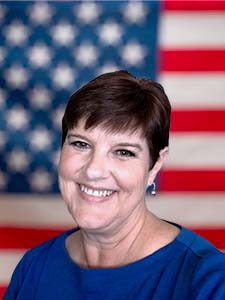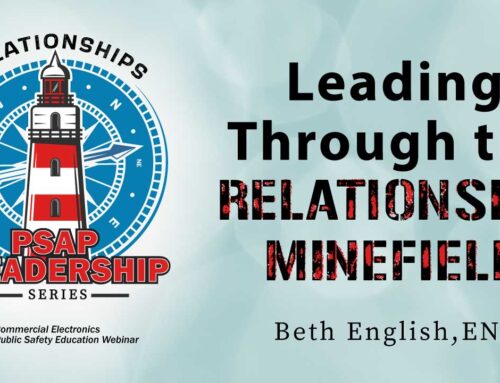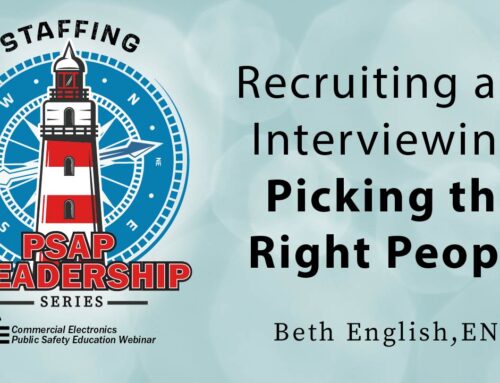Have you ever wondered how 9-1-1 works? Or wondered what all the fields mean in the ANI/ALI display? Or even what ANI/ALI is? Join us for a very basic introduction to 9-1-1 technology, taught by a non-engineer for non-engineers. This class is for new employees and those who aren’t new but want to understand how the magic happens.
FULL VIDEO TRANSCRIPT BELOW:
This is a VERY basic lesson, with small words. I am not a technical person, I don’t understand electricity and I don’t do math, so if you are here for a high-powered discussion, you are in the wrong place. Please exit stage left.
For the rest of us, if you’ve worked in 9-1-1 for more than an hour, you know there are thousands of acronyms being tossed around. You’re told what they stand for but not necessarily what they mean or what their function is. You know that citizens are calling in on 9-1-1, and on the admin lines, but you don’t know how the telephone knows the difference in order to send the call to the right line. Also, how does the phone system know that the 9-1-1 call should come to you as opposed to another agency, in another city, in another state?
Well, the best way to learn this is to start at the beginning and build on it as you go, and that’s what we’re going to do.
In the Beginning
In the beginning, communication was accomplished by the use of drum beats or smoke signals. Then came the telegraph, which worked by sending signals using electric currents and magnets that pointed to letters of the alphabet. Samuel Morse later developed the Morse code, which was a method of dots and dashes to indicate letters, in order to more quickly send messages across the wires. This is what was used until Alexander Graham Bell invented the telephone, again, based on electrical currents.
Analog: What is it?
You’ve probably heard someone mention analog at one time or another. Analog telephone lines transmit your voice as electrical signals in a range from 30 Hz to 3300 Hz, or 3MHz. The microphone in the telephone converts the sound from your voice into electrical waves, which travel down copper wires until they reach the other end, at which time the speaker in the phone converts the electrical signals back into sound waves. And just in case you’re wondering, a Hz is a unit of frequency. That’s as technical as I’m getting here because I had to look that up to tell you that.
Central Offices (CO) Established
The first telephones were directly connected from one customer’s location to another customer’s location, but as more customers were added that method became impractical. So, the telephone company established manually operated switchboards. Initially, these were installed in the operator’s home so customers could have 24-hour calling, but eventually they were moved to Central Offices, or COs, downtown. With the invention of the switchboard, customers who subscribed to the company’s communication service, would be connected directly to the CO using pairs of copper wires. When the customer wanted to make a call, they would have to either turn a crank or click the hook switch to alert the operator. The operator would then have to connect that customer’s circuit to the other customer’s circuit in order to establish the connection.
Boys in the CO
Initially, boys were hired to work the switchboard because it was believed they had the manual dexterity and mechanical knowledge to be able to connect hundreds of lines per hour. But between the wrestling matches, spit wad wars, jokes and the foul language they used with the customers, they were soon replaced by women.
Switchboard Automated
The switchboard was automated in 1891 when an undertaker in Kansas City, MO thought that the operators were telling callers his line was busy and were routing calls to his competitors. Thinking that callers, not operators, should choose who was being called, this undertaker invented the automatic telephone exchange. That eventually ended the need for switchboard operators, but long-distance operators were still in use into the late 1980’s.
Basic PSTN
The COs were eventually connected to form the PSTN, or the Public Switched Telephone Network. The telephone is located in the customer premise and the telephone switch is located in the CO. You have probably heard someone refer to your 9-1-1 equipment as customer premise equipment, or CPE, and that just means the telephone equipment at your site.
The telephone is connected to the CO with two copper wires, called a local loop, or a subscriber loop, or more often just a loop. This loop is a dedicated circuit between the customer and the CO and is what the operators used to have to connect manually. The COs are connected by telephone trunks. When a caller picked up the phone and dialed the telephone number, signaling was done from the loop, to the CO, and then to the party being called. This is what was called a dial-up, also known as POTS or Plain Ordinary Telephone Service. So, if someone asks you if your phones are POTS lines, they are asking if they are plain ordinary phone lines as opposed to being on a VoIP or digital system.
LEC/CLEC
After the telephone was invented, the American Bell Telephone Company was established. Over the years the company expanded, branching off into different phone companies providing service to different areas of the country. These telephone companies were known as LECs, or Local Exchange Carriers, which were dominated by the Bell telephone companies. The Telecommunications Act of 1996 was implemented to promote competition between local phone service providers in order to compete with the Bell Telephone companies. These local providers became known as CLECs or Competing Local Exchange Carriers. They offered lower prices for local and long-distance phone service and cable, and hundreds of these companies popped up everywhere. You will also hear the term ILEC, or Incumbent Local Exchange Carrier, and this refers to telephone companies that provided local service before the Telecommunications Act of 1996.
Basic 9-1-1
Now let’s look at 9-1-1. When 9-1-1 was invented in 1968, it was set up for calls to be delivered to a PSAP (Public Safety Answering Point) from a landline, or home or business phone, by use of dedicated copper trunks to the 9-1-1 switch. A CAMA trunk, or Centralized Automatic Message Accounting trunk, is a special analog trunk that was originally developed for long-distance billing but is now used mainly for emergency call service. Most agencies will have at least two sets of these trunks coming into the building from different directions to allow for redundancy. This prevents your 9-1-1 from going down completely due to your trunks being cut or from some other disaster. If you don’t know where these trunks terminate at your building, you might want to ask…it’s always good to know. With basic 9-1-1, only voice was delivered, no data, and it was delivered to a pre-determined PSAP. There are still agencies today that have only Basic 9-1-1.
Enhanced 9-1-1
Enhanced 9-1-1, or E9-1-1, was an upgrade to basic 9-1-1, using new databases to gather information to be delivered to the PSAP.
E9-1-1 brought in ANI/ALI, MSAG, CoS, ESN, and ELT, and allowed for selective routing with the selective router, or Tandem. You have probably heard that ANI and ALI are automatic number identification and automatic location identification, so let’s talk about what that means.
For billing purposes, the phone company had a database containing all the subscriber phone numbers. In order for E9-1-1 to work, the MSAG, or Master Street Address Guide, had to be developed. The MSAG contains all the addresses residing in a PSAP’s jurisdiction as well as the ESNs and ESZs, which we will cover in a minute.
When a call is placed to 9-1-1, it travels to several places to gather information to be presented on the ANI/ALI screen. The caller’s voice and ANI travel immediately to the PSAP. While that is happening, the MSAG is being queried to find the address, the ESN and the ESZ that correspond to that phone number. This information is then forwarded to the PSAP. Because of the importance of the ALI information, most agencies have access to more than one ALI database, and they will generally be geographically diverse. For instance, my main ALI database was maintained by a city about 40 miles north of my agency, while the secondary database was in Houston. You may receive a call from time to time from your LEC telling you that one of your ALI links is down. What this means is that one path to your ALI database is down, but you still have your secondary link to deliver the ALI. Now, while this information was originally maintained with your LEC, there are now third-party companies who provide the ALI links so you might want to find out who your provider is just in case. It never hurts to be prepared.
ESN/ESZ
Each address in the MSAG is assigned an ESN, which designates which police, fire and EMS agencies would respond to calls in that specific geographic area. This geographic area is known as an ESZ, or emergency service zone. For instance, your center answers 9-1-1 for the City of McKinney. The normal EMS response for McKinney would be AMR. But the ESN is 322, and even though it’s part of McKinney’s jurisdiction, Billy Bob’s EMS responds to that particular area. The ESN for that address would specify that there is a different response in that ESZ and would display it on the ANI/ALI screen.
ALI Screen
This response information is what is called the ELT, or English Language Translation. The ELT is used by the CPE to transfer calls to the correct responder, in this case McKinney 9-1-1.
The ALI screen also contained a CoS, or Class of Service, that was delivered with the call and gave information about the type of phone line the caller was calling from, such as RESD, BUSN, or COIN. For those of you who weren’t here then, coin phones used to be on every street corner and that was where Superman changed into his super costume.
Wireless Phase I
Now let’s talk about wireless 9-1-1. The “car phone” was developed in 1946 and evolved over time, and in 1981 the 1G system was developed. Although some people thought the cell phone was a phase that people would get over, cellular telephone technology changed and usage exploded in the 90’s, causing numerous problems for 9-1-1. After years of knowing where the caller was, all of a sudden we didn’t have a clue, but the public didn’t know that. About this time was when the answering phrase, “9-1-1, what is your emergency?” became, “9-1-1, what is the location (or address) of your emergency?” because we were back at square one, just like having basic 9-1-1 again. When a 9-1-1 call came in from a cell phone, even with enhanced 9-1-1 the call taker didn’t have any ANI/ALI information. So, the FCC created deadlines for wireless carriers to deliver the caller’s phone number and location information, but it was broken up into two phases.
Phase I allowed the phone number of the caller and the location of the cell site and sector to be delivered to the PSAP with the call.
Cell Towers
There were two types of cell towers, omni and directional. The omni towers received cell signals equally well from all directions.
Directional towers had three sectors, each of which faced a different direction. In urban areas, a directional tower may cover a different jurisdiction with each of the three sectors.
To assist with routing calls, pseudo ANIs, or pANIs, were created. Essentially, a 10-digit number was assigned to each sector, similar to an ANI, hence the name pseudo ANI. When the call was delivered to the PSAP, the caller’s phone number, cell tower location, sector, and pANI were delivered with the call. You also received a new CoS of MOBL, WRLS, or WPH1.
With the delivery of the cell sector information, if the cell tower location showed 1234 Main St., SW, then you knew the person was (hopefully) calling from a pie shaped radius that stretched southwest from 1234 Main St.
Phase I Wireless
A Phase I wireless call is delivered to the PSAP in voice and data separately, although you would never know it. While the voice, the pANI and the ANI go through a Mobile Switching Center, or MSC, and the End Office, also called the CO, before going through the selective router to be sent to the PSAP, the data takes a different path because it has to go to the ALI database before being delivered to the PSAP. The ALI database can be anywhere in the US, depending on the wireless carrier. The call may have to travel to Kansas to get the ALI, before going back to the PSAP in Florida. This happens so quickly that you generally won’t notice a delay.
Phase II Wireless
For Phase II wireless, it was required that the wireless providers deliver the X/Y coordinates of a call, or the longitude and latitude of the handset to the PSAP. There were two types of technology used and the accuracy requirements from the FCC were different for each of them.
Wireless Location Solutions
Some carriers used a handset solution in which the handsets were GPS enabled. Other carriers used a network-based solution, in which the lat/long of the handset was determined by the signal’s TDOA, or time difference of arrival at the cell towers, and the angle of arrival. When a wireless call is placed, the signal is picked up by three cell towers. Based on an algorithm with time difference and the angle the towers received the signal, the caller’s location was determined to be at a particular location. Because the network-based solution wasn’t as accurate as the handset-based solution, the accuracy requirements were more lenient.
Phase II Uncertainty, Confidence and Z-Axis
With Phase II wireless came another CoS, WPH2, along with other elements to indicate how accurate the location determination is. In addition to the lat/long, came the Uncertainty factor. The uncertainty factor tells us, in meters, how accurate the lat/long is that was delivered. For example, an uncertainty of 20 would indicate that the caller’s location is within a 20-meter radius of the lat/long provided.
The Confidence factor is a percentage and it tells if the call meets the 67% or 95% accuracy requirement of the FCC. The confidence factor works with the uncertainty factor and won’t be delivered without the uncertainty. But, let’s say you get a call that has an uncertainty of 20 with a confidence of 95. That means that the carrier is 95% certain that the caller is within a 20-meter radius of the lat/long provided.
Not all carriers provide the confidence and uncertainty so you may or may not see these in your wireless calls.
Z-Axis location is something the FCC has been working on in order to improve location information. The Z-axis is the vertical location of the caller. This would be useful for a wireless caller in a multi-story building who can’t give their location for whatever reason. Testing has been done on the technology and the major wireless providers have been given a deadline of April 3, 2021 to deploy it.
VoIP 9-1-1
VoIP or Voice Over Internet Protocol is another way that 9-1-1 calls may come in and can be another challenge to call takers. With VoIP, the signal can be carried by a modem, a DSL, T1, or a wired or wireless network that provides connectivity to the internet. So, what are a DSL or T1?
DSL is a Digital Subscriber Line and it allows you to get a high-speed connection from a telephone wall jack.
A T1 is a line that delivers high-speed connections. It can be channelized into 24 channels, so that it can carry 23 calls at one time and have one line for data, such as caller ID.
VoIP Packets
Although the caller doesn’t notice anything different, with VoIP the caller’s voice is digitized and converted into small data packets that are then sent over the internet and put back together as voice signals at the other end. The data packets don’t all arrive at the other end at the same time, but they are put back together at the same time. Every so often a packet can get lost and won’t be included at the end. This will come across as a slight hesitation, or sound like the phone line is cutting out, but it generally doesn’t affect the ability to understand the caller.
There are two types of VoIP; static and nomadic. Static VoIP can be provided by a cable company to a residence where the telephone doesn’t leave the home. The address is provided to 9-1-1 just as in a regular 9-1-1 call from a landline.
Nomadic VoIP is usually a VoIP phone in a portable computer that can be taken with the subscriber. The problem with nomadic VoIP is that the address must be provided by the owner. If the computer is moved, the subscriber must remember to update their address, which they often don’t do. So, for instance, a caller might move from Texas to New York and forget to update their address. When they dial 9-1-1, the call is routed to the PSAP from their previous address, in Texas.
With VoIP, we got another CoS of VoIP.
Kari’s Law
Most of you may have heard of Kari’s Law by now, which pertains to the use of MLTS, Multi-Line Telephone Systems, or PBXs, Private Branch Exchange.
PBX systems have been in use for a long time and they have had two major challenges, one of which was the requirement of MLTS systems to dial an 8 or 9 to get an outside line in order to place a call. This is where Kari’s Law came in. It stemmed from an incident in Marshall, TX in which a woman named Kari Hunt Dunn was attacked by her estranged husband. Her daughter, who was 9 years old at the time, tried to call 9-1-1 as she had been taught, but she was unaware that she had to dial 9 to get an outside line. Because her call never went through, her mother died. Afterwards, Kari Hunt Dunn’s family worked to have a law implemented that required all MLTS systems to allow users to call 9-1-1 without having to dial a prefix for an outside line.
MLTS/PBX
Another challenge has been the issue of businesses with multiple branches being on one PBX. You will have a bank, for instance, that has a branch on Texas St., one on Main St., and another in Brother Town, 10 miles away. When anyone from one of those branches dials 9-1-1, the call will go to the PSAP of the branch where the PBX is located. If that branch is on Main St., but the caller is at the branch in nearby Brother Town, the ALI is going to show the address of the Main St. branch. The ANI will show the main number of the bank, so the call taker won’t have a good call back number.
Drinking From the Firehose
If this is how you feel after reading all of this, trust me, I feel your pain. We tend to go through telecommunicator training learning how to do the job, never wondering how all the magic happens. When you find out how much actually goes into delivering these calls, it can make you feel like you are drinking from the firehose.
One thing to keep in mind, though, is that the more you know the better you are able to do your job. So, don’t stop at learning how to do it, but keep trying to find out what makes it possible for you to do it.
Unfortunately, this only covers the very tip of the iceberg. We haven’t even begun to get into what’s coming with NG9-1-1, so stay tuned for Episode 2 when we go forward with even more technology you always wondered about but were afraid to ask!

After 36 years as a public safety communications professional, Beth English is a believer in PSAP QA. She has seen firsthand, the positive effects QA can have on an agency, both internally and externally. Beth has been a popular trainer, presenting at state and national telecommunicator training conferences on topics that have included contingency planning, public education, employee recognition, in addition to productive and constructive criticism. She earned her Master Telecommunicator Proficiency Certification from Texas Commission on Law Enforcement (TCOLE) and served as President of the Texas Chapter of the National Emergency Number Association (NENA). During her time with us at Commercial Electronics, Beth wore multiple hats including developing this webinar training series geared toward public safety telecommunicator professionals which we continue to make available.





